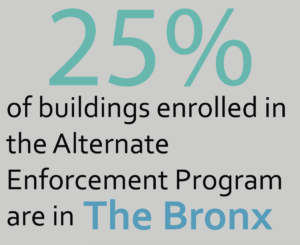
More than 10% of Bronx residents lived in an apartment this past year that had at least one hazardous housing violation.
Since October 2018, 14 out of every 100 people who lived in the Bronx lived in a unit that recorded a violation, ranging from a less serious Class I Violation, to an immediate hazardous violation called a Class C.
This rate is the highest number of any borough, according to Housing Maintenance Code Violations NYC Open Data.
The city government agency responsible for overseeing the health and safety of New York City apartments is Housing Preservation and Development.
HPD inspects buildings and upholds the New York City Housing Maintenance Code, which protects tenants’ rights to fire safety, heat and hot water, and protects them from gas leaks, rodents and mold.
When HPD receives a complaint, it sends inspectors to the apartment to verify the complaint and look for other possible violations, according to Juliet Pierre-Antoine, HPD Press Secretary. If the landlord is found to be in violation, HPD is responsible for making sure the problem is fixed, either by issuing a fine or taking the owner to court.
“It’s a complete complaint-driven enforcement service that we provide,” said Pierre-Antoine. “It’s our job to hold landlords accountable, basically making sure they’re taking care of their responsibilities as a building owner for the renter in New York.”
If the violation isn’t fixed, HPD offers legal help to the tenant to take the landlord to court, she said.
Landlords can be fined up to $500 per day for a heat violation and up to $1,000 per day for other violations for a limited time period, according to the Metropolitan Council on Housing.
If the situation is dangerous, HPD also has an Emergency Repair Program. It is unclear how often it happens, but last year HPD repaired $1.7 million in heat-related emergency repairs, according to a press release.
“In an especially hazardous condition we can have a team go out to correct the actual area of a concern that is dangerous to a renter and then we will bill the landlord for that work,” Pierre-Antoine said.
Landlords who repeatedly violate codes, or find themselves in trouble with the court or with HPD, can be enrolled in a program called the Alternate Enforcement Program, which is also sometimes called the “babysitting program.”
“That basically means that they have a certain number of violations or a certain number of civil penalties that qualify them to be on the list,” said Pierre-Antoine. “We’re basically acting like a very aggressive babysitter because we do not think that they are doing right by their tenants and they need someone to watch over them.”
Since 2007, more than 3,600 buildings have been enrolled in The Alternate Enforcement Program throughout the city, according to Alternate Enforcement Program NYC Open Data. There are currently 710 buildings enrolled across the boroughs. Almost a quarter of them are in the Bronx.
One of the buildings enrolled in AEP is 1895 Walton Avenue. This building was acquired last December by NCV Capital Partners and Lemor Development Group as part of a 13-building portfolio the organizations are repairing, according to Keith Gordon, of NCV Capital Partners.
Lemor Development Group has been fixing aging housing for 30 years as part of its mission to provide quality housing and restore buildings, according to Mariaelena J. Paris, of Lemor Development Group and Mount Hope Renaissance HDFC.
“I have experience getting buildings out of AEP,” Paris said. “One of the reasons we even took on this building and the other buildings is to get them out of AEP. We are fixers.”
The time to resolve emergency complaints decreased this year, according to the Mayor’s Management Report. On average, emergency complaints were closed in 10.4 days and non-emergency complaints in 17.7 days.


